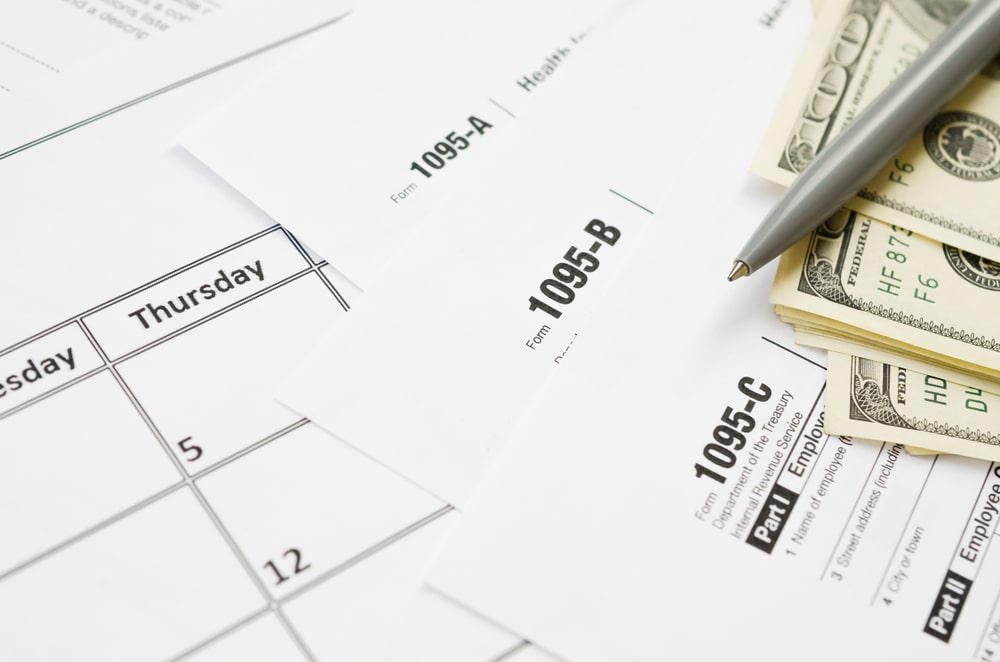
Here’s How to Get Your 1095-a [AND Fill it Out]

Whether you work as a freelancer, gig worker, or in an office space, you’ll be getting a 1095 form when tax season rolls around. This form is essential to anyone enrolled in a healthcare plan.
You can find excellent health coverage for yourself and your family on the marketplace or from your employer. To ensure that you get the most out of your health insurance plan, you’ll have to file the correct taxes for your health insurance plan.
So what is this form, and more importantly, how do you fill it out?
Read on for our comprehensive guide to filling out form 1095.
Learn how to obtain self-employment insurance in your field:
Freelance Disability Insurance | Freelance Ghost Insurance | Freelance Workers Comp Insurance | Freelance Critical Illness Insurance | Freelance E&O Insurance | Freelance Airbnb Host Insurance | Freelance Commercial Auto Insurance | Freelance Commercial Property Insurance | Freelance Utah Home Insurance | Freelance Amazon Flex | Freelance Carpet Cleaning Insurance | Freelance Window Cleaner Insurance | Freelance Pressure Washer Insurance | Freelance Electrician Insurance | Freelance Mechanic Insurance | Freelance Junk Removal Insurance | Freelance Bartender Insurance | Freelance Hair Stylist Insurance | Freelance Barber Insurance | Freelance Taskers Insurance | Freelance Web Designer Insurance | Freelance Doordash Driver Insurance | Freelance Uber Driver Insurance | Freelance Plumber Insurance | Freelance Writer Insurance
What Is a 1095 Form?
If you or anyone in your family obtains your health insurance through the Health Insurance Marketplace, you will receive a 1095 form.
A 1095 is a tax form used to help determine your premium tax credit for your health insurance plan. You must include the information from your form 1095 on your tax return for the appropriate tax year.
You can use your premium tax credit to lower your monthly insurance payment.
This tax credit is based on your income estimate and household info. How much of your tax credit you use toward your premium is up to you.
Filling out the 1095 form will help you determine how much of a tax credit you are eligible for with your health insurance plan.
Choosing Health Insurance
Choosing the right health insurance plan for you and your family can be confusing, but it ultimately comes down to your needs for coverage.
Freelancers and gig workers have a lot to take care of, but choosing health insurance is vital to keeping you and your family happy and healthy.
The Health Insurance Marketplace was formed as a part of the Affordable Care Act (ACA). It provides options for everyone to find health insurance plans that work for them.
Factors in Choosing Health Insurance Coverage
One factor to consider when choosing health insurance on your marketplace account is if you are looking for a policy just for yourself. If you also want to cover family members, you may need a more comprehensive policy to help with that.
As a freelancer, different gigs involve various levels of risk. If you are a freelance writer, you will probably need less coverage than a freelance carpenter. With the increased risk involved in a trade like carpentry, you’ll want to ensure you have all the coverage you need in case of an on-the-job accident.
Health Coverage Options for Freelancers
Everyone needs health insurance tailored to their needs, so if you work as a freelancer or gig worker and don’t know where to start, check out Selfgood.
An online account through Selfgood offers competitive benefits for gig workers, freelancers, and small business owners. If you are looking for essential health benefits while freelancing, you can find plenty of resources and financial help options through Selfgood.
Not every plan will work for every freelancer, so be sure to take the time to find the plan that will work best for your flexible lifestyle.
Related: Supplemental Benefits for Independent Contractors, Entrepreneurs, and Freelancers
What is on a 1095 Form?
A 1095 form will tell you the following:
- Dates of coverage
- The total amount of monthly premiums for your plan
- Benchmark/second lowest cost Silver plan premium (SLCSP)
- Amounts of advance payments of the premium tax credit
Your 1095 form will outline everything that is part of your healthcare plan. This includes how long your coverage lasts from the start date to the end date. It will also add up the monthly premium amount for your chosen plan. This is the total of your monthly premium for the previous year.
The form will also detail the benchmark plan in your area. Since health care coverage and taxes depend on location factors, the benchmark plan can change from state to state. This benchmark will also help you determine how much of a premium tax credit you may be eligible for.
The last thing your 1095 form will tell you is how much money you paid in advanced premium tax credits. When you fill out your 1095, you may find that your estimated premium was higher than what it turned out to be. If this is the case, the form will help determine if you are eligible for a refund or have to pay a difference.
Your form 1095-a won’t have anything to do with your annual income tax, but you will have to include it on your federal tax return.
Subscribe To SelfGood
Get up to date perks and Gigworker news. Easy. Simply. SelfGood. Subscribe.
Am I Eligible for a Premium Tax Credit?
When filling out your 1095, you will be trying to determine if you qualify for a premium tax credit.
Your eligibility for the premium tax credit is based on your estimated income. This number will change if you file for yourself or live in a house with a family. It will also vary depending on how many members of your household you include.
The premium tax credit income range is based on the federal poverty level (FPL).
The income range to qualify for the tax credit is between 100%-400% of the FPL.
In the past, those with an income over 400% were not eligible for the premium tax credits. However, under the American Rescue Plan Act, this exemption is currently not in place for the tax years 2021 and 2022.
Here are some figures to help you figure out if you might have a qualified health plan for a premium tax credit.
In 2021 the income range to qualify for a single person was $12,800-$51,520; the range for a family of four was $26,500-$106,000.
These ranges will change based on how many people are a part of your household or if you moved to a different state during the year.
How do I Get my 1095 Form?

Unlike other tax forms sent to you by the IRS, your 1095 form comes directly from the Health Insurance Marketplace. They will mail the form to you and the IRS. You will not need to worry about the IRS Form when filling out your own form 1095-A.
1095 forms are sent to households by January 31st — keep an eye out for your form between January and March. If you find you haven’t received your form in a timely manner, you can contact your health insurance company. They will be able to supply you with a copy of your form or ensure that one will send to your house.
Some states even offer electronic forms now. You might be able to get an electronic form if you sign up for your health insurance through a state-based option.
If you are working with a tax preparer, you can bring your form 1095-A to them with your income tax return and other tax forms when tax season rolls around.
Which 1095 Form Will I Get?
Depending on your health plan and circumstances, you will get one of three main types of 1095 forms.
The three forms are:
- 1095-A (Health Insurance Marketplace Statement)
- 1095-B (Health Coverage)
- 1095-C (Employer-Provided Health Insurance Offer and Coverage)
Form 1095-A
Form 1095-A is the basic form that taxpayers who signed up for health insurance plans on the marketplace will get. Most freelancers and gig workers that work for themselves will get form 1095-A.
This is directly from your health insurance provider and will ask you for all the basic information needed.
Form 1095-B
If you work for a small company with 50 or fewer people that offers health insurance, your employer will send out form 1095-B. Maybe you started your own small business and have less than 50 employees and provide full health insurance for those employees.
You will have to send this form to all the enrollees on your company’s health insurance plan. Form 1095-B will have information on the coverage type, how long that coverage is, and any dependents that use that coverage.
You may also get form 1095-B or form 1095-C if your health insurance is through a government program (e.g., Medicare or Medicaid).
Form 1095-C
If you work for a big company or find your small business has grown past 50 employees, you will get form 1095-C. This document is for all employees that are a part of a company’s health care plan.
You can find more in-depth information and faqs on irs.gov.
Discover: What is Critical Illness Insurance?
How do I Fill Out My 1095 Form?

Once your 1095 shows up in the mail, it’s time to fill it out.
Your health insurance marketplace provider will fill out the beginning of the form. It will include information like the name of the marketplace provider and the name of the person receiving the form (you).
From there, you will have to fill out tax information such as your social security number. Sign up for a healthcare.gov account to access an outline of all the critical information you need to provide for this form.
If there are any errors on the form while you’re filling it out, you should contact your health insurance marketplace provider. They will be able to send you a corrected form.
What If I Get Multiple 1095s?
You may also receive more than one 1095 form in the mail (and it’s nothing to worry about!). It just means that other household members were not enrolled in the same healthcare plan.
You may have also switched plans throughout the year or moved. If you receive multiple 1095 forms, you’ll get another form (Form 8962) that will make it easy to keep all the information together.
Overall, you should make sure that you have a complete form before submitting it for tax filing.
What Happens Next?
You’ve filled out all your forms and sent them back to the IRS for filing.
So what now?
You’ll be able to determine if you qualified for a premium tax credit and what that means for your payment moving forward. After you file your 1095 form, two things can happen.
Advanced Payments
First, you may see advance premium tax credit (APTC) payments made on your behalf when you get your 1095. If this is the case, you will have to pay the difference. This means that when you get your 1095 back, it shows that advanced payments were made that covered your premium tax credit.
When you first enroll in a healthcare plan with the marketplace, they will estimate your premium tax credit based on your income and household factors. They will then pay the advanced premium, and if the number comes out to be more than your premium when you fill out your 1095, you’ll have to pay the difference.
It’s essential to make sure you accurately fill out your 1095 every year to get the best estimate of your premium tax credit. This can help you avoid a hefty amount to pay back during tax season. Your 1095 form is vital for your health insurance and coverage for you and your family.
Refunds
If you paid more than your estimated premium, you will get the difference as a refundable credit when you file the rest of your taxes. This means that you have paid more monthly than you would with your tax credit.
That’s good news: it means you’ll get some money back!
This is very similar to getting a federal income tax refund after tax season. You can then decide how much you want to pay moving forward with your new monthly premium cost.
Freelancers know how important it is to stay organized. When tax season rolls around, you want to be prepared to fill out your 1095 along with your other tax forms and federal income tax return.
Conclusion
If you are on a health insurance plan through the marketplace, you must take the time to fill out your 1095 form accurately. If you don’t, you may not know that you qualify for a tax credit that can help ease your health insurance payments over time.
Choosing health insurance can be tricky, but using resources like Selfgood can help you find a perfect plan for you and your family. You already know how to fill out tax forms as a gig worker, so make sure you keep the 1095 in the mix when tax season rolls around this year.
Join the Alliance of Gig Workers by signing up for Selfgood now!





